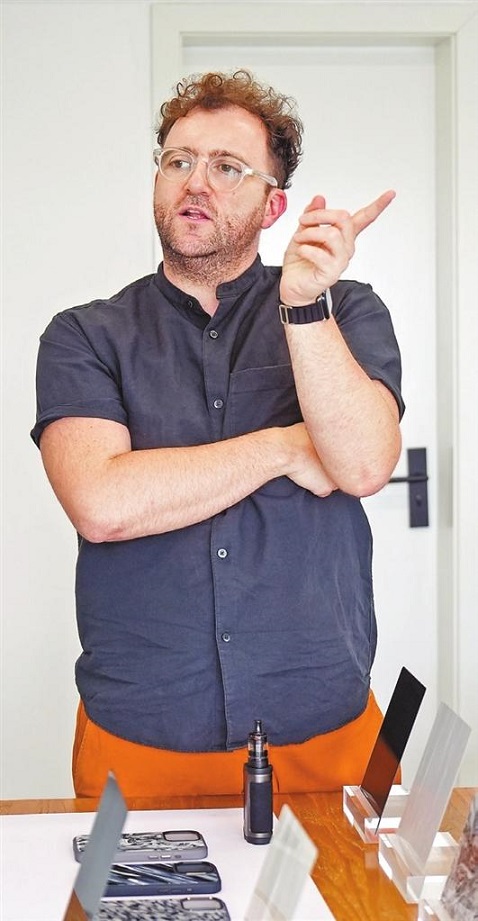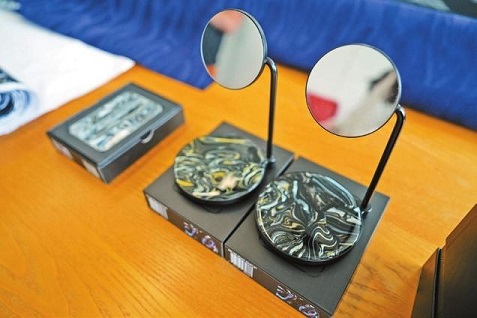Shenzhen
 2024/11/1
2024/11/1
 source: Shenzhen Daily
source: Shenzhen Daily
 Print
Print

Eduardo Alessi shares insights into his entrepreneurial journey in Shenzhen. Photos by Lin Jianping

Materik wireless chargers designed by TROVITechnologies.
Zhang Yu
JeniZhang13@163.com
AS the first Chinese city recognized as a UNESCO City of Design, Shenzhen has seen dynamic growth in its creative and design sectors, capturing the interest of designers from around the globe. The city’s spirit of innovation and rapidly evolving market offer many opportunities and a wellspring of inspiration for those in the design field.
Eduardo Alessi, who hails from the charming Tuscan city of Prato, Italy, is one of the many international designers who have embraced the city’s spirit and actively engage with its industrial design and supply chain landscapes.
Design as language
Alessi was originally enrolled in a technical school with a focus on mechanics. The allure of design — a promise of creativity and problem-solving — drew him to the industrial design sector. After graduating from the University of Florence, Alessi spent time in the U.S. honing his skills and broadening his horizons.
However, the call of his homeland was strong, and he returned to Florence and set up his own studio. Freelancing led him down an unexpected path. With a significant portion of his clients based in China, he had to regularly travel between Italy and China.
Alessi decided to make Shenzhen his new home in 2018. Soon, he took on the role of design director for TROVITechnologies Co. Ltd., an Italian company nestled in Shekou, Nanshan District. The company specializes in industrial design and supply chain management, with a keen focus on material design and the development of sustainable materials.
Alessi views design as a language that needs to be as clear and simple as possible. “We don’t over-design. We don’t over-create things or show off.”
Meanwhile, his approach to design is refreshingly open-minded, a philosophy that eschews cookie-cutter solutions for tailored, client-centric strategies. “We really believe that material is the core of every design process,” he told Shenzhen Daily.
One of TROVI’s crowning achievements was the birth of Materik, a brand of accessories that celebrates the uniqueness of materials. Alessi and his team scoured Italy for the finest materials, eventually finding a company near Milan with a legacy of over 150 years of expertise that now leads globally in cellulose acetate production.
The time-honored company’s handcrafted materials, traditionally used in the eyewear industry, are transformed into tech accessories via Materik, with each piece reflecting the marriage of tradition and innovation.
In the delicate dance between aesthetics and functionality, Alessi leans on the adage that form follows function. Yet, he also understands the importance of emotional connection, believing that materials can foster a unique bond between products and users.
This belief drives him to seek out exquisite materials that tell a story. “We begin with selecting the right material, and we believe that the material can forge an intimate connection with the users,” he noted.
A deep dive into Shenzhen
Shenzhen, with its refreshing sea breezes and pulsating design scene, captured Alessi’s heart. Residing and working in the coastal area of Shekou is a delight for him because the sea, a constant in his Italian heritage, serves as his sanctuary for relaxation.
He especially appreciates the city’s energy, its proximity to manufacturing hubs, and the collaborative spirit of its design community. “The city gives me a chance to learn and grow. In Shenzhen, we share experiences with designers from various backgrounds, each bringing a unique perspective to the table,” the Italian designer shared.
According to Alessi, TROVI is like a bridge between the West and the East. It not only helps Western clients develop and manufacture their products in China, but also serves as a consultant that guides Chinese brands through the maze of design and manufacturing.
The company has collaborated with a number of Chinese clients, including the renowned mobile phone brand OnePlus. “It’s a fun project to work with, because we always like to work with people from different backgrounds. It was like exchanges of ideas and expertise,” Alessi said.
As Alessi looks to the future, his strategy for TROVI in China is clear — follow the entire production chain, from design to manufacturing, with a keen eye on materials and market trends. The dream? To build the most extensive material library in China, a repository that will not just catalog materials but also drive innovation in the design field. “We are always willing to collaborate with more Chinese clients. That’s why we are here,” he said.
When asked if he had any advice for young designers, Alessi, with a modest smile, said, “I still need to improve like everybody else.” Nevertheless, he suggested that young designers visit factories more often, work to understand technology, and find their own path, style, and voice in the world of design.





